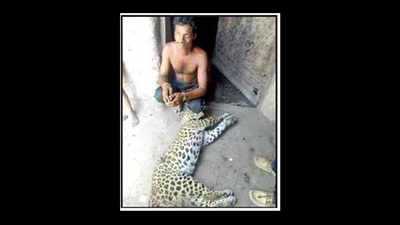- News
- City News
- jaipur News
- Leopard killed in Udaipur as toll hits 17 this year in Rajasthan
Trending
This story is from May 22, 2018
Leopard killed in Udaipur as toll hits 17 this year in Rajasthan
Leopards straying out of forest areas and dying in man-animal conflicts has become a common phenomenon in Rajasthan.

Gala Ram with the dead leopard in Salumbar on Monday
JAIPUR: Leopards straying out of forest areas and dying in man-animal conflicts has become a common phenomenon in Rajasthan. However, these spotted cats, which are listed on par with the tigers under Schedule I of the Wildlife Protection Act (WPA) 1972, are not even safe inside the forest area.

In a shocking incident, a one-and-half-year-old leopard was shot dead by a tribal with a country-made rifle on Monday in Salumbar forest range of Udaipur district.The forest department arrested one Gala Ram and is looking for three other accused who fled from the spot.
Weapon seized, probe on
“The department will investigate if the leopard has been killed for its skin and who gave the ‘purchase’ order for it,” forest department sources said.
The situation has become worse although Rajasthan was the first state in the country to announce a project to conserve leopards by improving their prey base, mitigating conflicts with humans and controlling poaching.
Since the beginning of this year, a leopard’s death has been recorded every week in some or the other parts of the state. A big concern is that more than half of these killings are said to be unnatural—caused by road accidents, electrocution or due to man-animal conflicts.
As per the data available with TOI, 17 deaths of leopards were recorded till May 21 this year. Dr Joy Gardener, wildlife conservationist, said, “In the recent past, wildlife crimes have increased. However, the forest department lacks expertise to tackle poaching or hunting. The department should promote local villagers and conservationist to assist them to keep a check on these incidents. Moreover, these animals are getting vulnerable as wildlife photographers share the location on social media. The poachers are active on internet and it’s easier for them to trace the animal.”

In a shocking incident, a one-and-half-year-old leopard was shot dead by a tribal with a country-made rifle on Monday in Salumbar forest range of Udaipur district.The forest department arrested one Gala Ram and is looking for three other accused who fled from the spot.
Weapon seized, probe on
R K Jain, district forest officer, Udaipur, said, “A case has been registered against the criminals. The weapon was seized by our staff and we are investigating the case.”
“The department will investigate if the leopard has been killed for its skin and who gave the ‘purchase’ order for it,” forest department sources said.
The situation has become worse although Rajasthan was the first state in the country to announce a project to conserve leopards by improving their prey base, mitigating conflicts with humans and controlling poaching.
Since the beginning of this year, a leopard’s death has been recorded every week in some or the other parts of the state. A big concern is that more than half of these killings are said to be unnatural—caused by road accidents, electrocution or due to man-animal conflicts.
As per the data available with TOI, 17 deaths of leopards were recorded till May 21 this year. Dr Joy Gardener, wildlife conservationist, said, “In the recent past, wildlife crimes have increased. However, the forest department lacks expertise to tackle poaching or hunting. The department should promote local villagers and conservationist to assist them to keep a check on these incidents. Moreover, these animals are getting vulnerable as wildlife photographers share the location on social media. The poachers are active on internet and it’s easier for them to trace the animal.”
End of Article
FOLLOW US ON SOCIAL MEDIA










